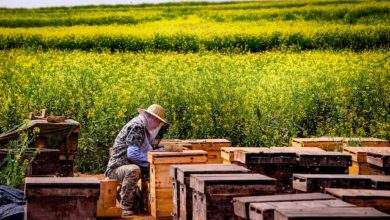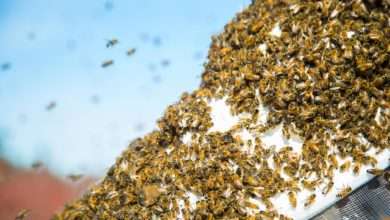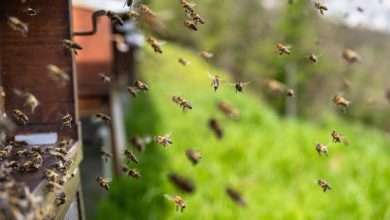Is 5G Harming the Bees?

The rapid advancement of technology has ushered in the era of 5G, promising faster speeds, lower latency, and the ability to connect more devices than ever before. While this new frontier holds great potential for innovation and connectivity, concerns have been raised about its potential impact on the environment, particularly on bee populations. As the guardians of our ecosystems, bees play a crucial role in pollination and food production, making their well-being essential for biodiversity and food security.
In this article, we will explore the intersection of 5G technology and bees, examining the potential risks, ongoing research, and possible solutions to ensure the coexistence of technological progress and environmental protection.
How 5G Technology Works:
- 5G technology offers faster speeds and lower latency, allowing for quicker data transmission and improved connectivity.
- The increased connectivity and device capacity of 5G networks enable more devices to be connected simultaneously, paving the way for the Internet of Things (IoT) to expand.
- Unlike previous generations of wireless technology, 5G utilizes higher frequency radio waves to transmit data.
- To support the higher frequencies used in 5G, small cell network infrastructure is being deployed in urban areas to create a denser network of antennas.
Research on the Effects of 5G on Bees
As 5G technology continues to roll out around the world, concerns have been raised about its potential impacts on the environment, including the health of bees. Bees play a crucial role in pollination and maintaining biodiversity, so understanding how 5G may affect them is of utmost importance.
Studies Evaluating the Impact of Electromagnetic Radiation on Bees

Researchers have been conducting studies to evaluate the effects of electromagnetic radiation, particularly from 5G networks, on bees. These studies aim to determine whether the increased exposure to radiation could have a negative impact on bee populations.
Findings on Behavioral Changes and Colony Health
Some studies have shown that exposure to electromagnetic radiation can lead to behavioral changes in bees, such as decreased foraging activity and communication within the colony. Additionally, researchers have found evidence of reduced colony health and lower honey production in bees exposed to high levels of radiation.
Potential Mechanisms for Harm, including Disruption of Navigation and Communication
One of the potential mechanisms for harm identified by researchers is the disruption of bees’ navigation and communication systems. Electromagnetic radiation may interfere with the bees’ ability to navigate back to the hive or communicate with other members of the colony, leading to disorientation and a decline in overall productivity.
Conflicting Results and the Need for Further Research
While some studies have indicated negative impacts of 5G radiation on bees, there have been conflicting results in other studies. This inconsistency highlights the need for further research to fully understand the effects of 5G on bee populations.
Calls for Precautionary Measures and Regulatory Action
Given the potential risks identified in some studies, there have been calls for precautionary measures and regulatory action to protect bee populations from the potential harms of 5G radiation. This includes implementing guidelines for the siting of 5G infrastructure to minimize exposure to bees and conducting more research to better understand the long-term effects of 5G on bee health.
Research on the effects of 5G on bees is still ongoing, but the findings so far suggest that there may be cause for concern. It is essential to continue studying this issue and take appropriate measures to protect bee populations and preserve their vital role in ecosystems.
Protecting Our Pollinators in the Age of 5G
With the rapid development and deployment of 5G technology, concerns have been raised about the potential harm it may have on our bee populations. As these crucial pollinators continue to face threats such as habitat loss, pesticide exposure, and climate change, it is imperative that we take steps to ensure their protection in the face of technological advancements.
Possible solutions and next steps
- Development of 5G technology that minimizes environmental impact: Researchers and scientists must work together to develop 5G technology that is safe for bees and other wildlife. By minimizing the environmental impact of this technology, we can help ensure the well-being of our pollinators.
- Collaboration between the telecommunications industry and environmental organizations: By working together, industry leaders and environmental organizations can develop strategies to protect bee populations while still advancing the capabilities of 5G technology. This collaboration is crucial in finding sustainable solutions for the coexistence of technology and nature.
- Integration of bee-friendly practices into urban planning and infrastructure design: City planners and developers can incorporate bee-friendly practices into their designs, such as planting pollinator-friendly gardens and creating green spaces that support bee populations. These initiatives can help create safe havens for bees in urban environments.
- Public awareness and education on the importance of protecting bee populations: Educating the public about the vital role that bees play in our ecosystem is essential for garnering support for bee conservation efforts. By raising awareness about the threats facing bees and the actions we can take to help them, we can inspire individuals to make a positive impact.
- Policy recommendations and guidelines for the responsible deployment of 5G networks: Government officials and policymakers can implement regulations and guidelines to ensure the responsible deployment of 5G networks. By establishing policies that prioritize environmental conservation and protect bee populations, we can mitigate the potential harm that 5G technology may have on our pollinators.
By implementing these solutions and taking proactive steps to protect our pollinators, we can create a future where bees can thrive alongside advancing technologies. It is up to us to prioritize the well-being of these crucial pollinators and ensure that they continue to play their vital role in our ecosystem.
The Importance of Preserving Bee Populations
- Bees play a crucial role in pollination, helping to fertilize plants and ensure the production of fruits, vegetables, and seeds. Without bees, many plant species would not be able to reproduce, leading to a decline in food production.
- The declining bee populations have significant consequences for agriculture and the environment. As bee numbers decrease, crop yields are affected, leading to lower food supplies and increased prices. In addition, the loss of bees can disrupt ecosystems and affect the biodiversity of plant and animal species.
- Protecting bees is crucial for the environment and agriculture. By preserving bee populations, we can help maintain healthy ecosystems, promote biodiversity, and ensure the sustainability of food production. Farmers and gardeners can support bee populations by planting bee-friendly flowers, avoiding the use of pesticides harmful to bees, and providing habitats for bees to thrive.
Bees are essential pollinators that play a vital role in food production and ecosystem health. By recognizing the importance of preserving bee populations and taking action to protect them, we can help safeguard the future of our environment and agricultural systems.
The Role of Technology in Protecting Bees
In today’s digital age, technology plays a crucial role in monitoring and protecting bee populations. From innovative monitoring devices to studying the effects of electromagnetic radiation on bees, technology is at the forefront of efforts to safeguard these essential pollinators.
Innovative technology to monitor bee populations
- Researchers and beekeepers have developed various innovative tools to monitor bee populations, such as remote hive monitoring systems and tracking devices.
- These technologies provide real-time data on bee behavior, health, and movement, allowing beekeepers to identify potential threats and intervene when necessary.
- By monitoring bee populations more effectively, researchers can better understand the factors contributing to bee population decline and implement targeted conservation strategies.
Use of technology to study the effects of electromagnetic radiation on bees
- With the rise of wireless technology and 5G networks, concerns have been raised about the potential impact of electromagnetic radiation on bees and other pollinators.
- Scientists are using technology to study the effects of electromagnetic radiation on bees, including tracking bee behavior near cell towers and conducting controlled experiments.
- By understanding how electromagnetic radiation affects bees, researchers can develop guidelines and regulations to protect bees from harm and minimize the impact of wireless technology on pollinators.
Technology has a pivotal role in protecting bees and ensuring their survival in a rapidly changing world. By harnessing the power of innovation and research, we can continue to safeguard these vital pollinators for future generations to come.
Conclusion
The potential harm caused by 5G to bees has become a pressing concern as the technology continues to proliferate. It is essential to prioritize further research into the impact of 5G on bee populations and explore measures to protect them from potential harm.
Preserving the well-being of bees is not only crucial for the environment and agriculture but also for the broader sustainability of ecosystems. As 5G technology advances, it is imperative to consider the potential impact on bee populations and take proactive steps to safeguard their vital role in the natural world.

FAQ:
What is 5G technology, and how does it potentially harm bees?
- 5G technology is the latest generation of wireless communication, promising faster and more reliable connectivity. The potential harm to bees is related to the electromagnetic radiation emitted by 5G, which has been found to disrupt bee behavior and interfere with their navigation and communication abilities.
Are there any scientific studies supporting the claim that 5G technology harms bees?
- Yes, several scientific studies have indicated a correlation between 5G technology and negative effects on bee populations. These studies suggest that electromagnetic radiation from 5G networks can lead to decreased bee health, increased mortality rates, and disruption of their natural behaviors.
How can beekeepers protect their hives from the potential harm of 5G technology?
- Beekeepers can take several measures to protect their hives from the potential harm of 5G technology, such as placing hives in areas with minimal exposure to electromagnetic radiation, using shields or barriers to block radiation, and monitoring bee behavior closely for any signs of distress or disruption.
What are the potential consequences of 5G technology on honey bee colonies?
- The impact of 5G technology on honey bee colonies can be significant, as studies have shown that exposure to electromagnetic radiation from 5G networks can disrupt their foraging patterns, communication within the hive, and overall well-being. This can result in decreased pollination rates and ultimately harm the ecosystem.
How can beekeepers raise awareness about the potential risks of 5G technology to bees?
- Beekeepers can raise awareness about the potential risks of 5G technology to bees by educating the public, collaborating with environmental organizations, and advocating for policies that prioritize bee health and safety. By sharing information and engaging in conversations about this issue, beekeepers can help protect bee populations from the harmful effects of 5G technology.
How can consumers support beekeepers in their efforts to protect bees from the potential harm of 5G technology?
- Consumers can support beekeepers in their efforts to protect bees from the potential harm of 5G technology by choosing products and services from companies that prioritize environmental sustainability and bee-friendly practices. By supporting bee-friendly initiatives and advocating for bee health, consumers can play a crucial role in ensuring the well-being of bee populations in the face of technological advancements.




